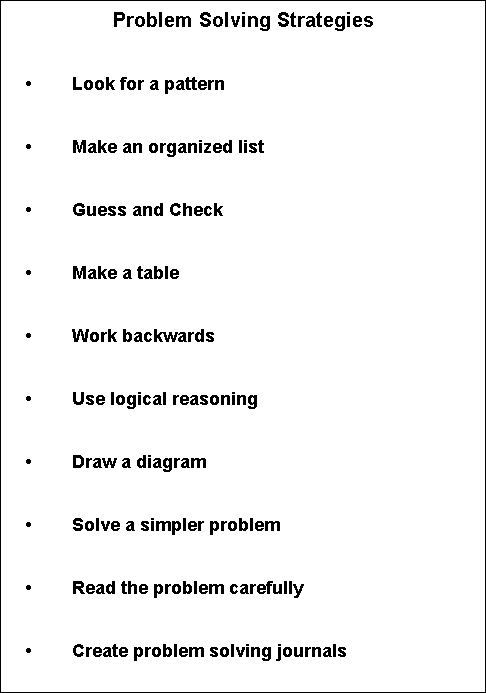So I have a test coming up on Thursday. I try to keep these problem solving strategies in mind, while taking my test. G. Polya wrote a book titled 'How To Solve It' in 1957. I look at all math problems with "What type of information is being asked for?" I got that from word problems early on. Picking out all of the important information and seeing the problem through. Then going back through the problem to make sure I did not miss anything.
I liked this diagram because it really gives you examples of each step. I feel like if I didn't get it the first time, I might not get it. This can be really discouraging. Don't be afraid to walk away and come back later. Sometimes things need to process. If it is in a test taking situation, skip the question come back to it.
I liked this diagram because it really gives you examples of each step. I feel like if I didn't get it the first time, I might not get it. This can be really discouraging. Don't be afraid to walk away and come back later. Sometimes things need to process. If it is in a test taking situation, skip the question come back to it.
I received my images : http://fcit.usf.edu/fcat8m/resource/fcat/strat.htm
- Look for a pattern
Example:
Solution:Find the sum of the first 100 even positive numbers. The sum of the first 1 even positive numbers is 2 or 1(1+1) = 1(2).
The sum of the first 2 even positive numbers is 2 + 4 = 6 or 2(2+1) = 2(3).
The sum of the first 3 even positive numbers is 2 + 4 + 6 = 12 or 3(3+1) = 3(4).
The sum of the first 4 even positive numbers is 2 + 4 + 6 + 8 = 20 or 4(4+1) = 4(5).Look for a pattern:
The sum of the first 100 even positive numbers is 2 + 4 + 6 + ... = ? or 100(100+1) = 100(101) or 10,100.
- Make an organized list Example:Find the median of the following test scores: 73, 65, 82, 78, and 93.Solution:Make a list from smallest to largest:
65
73
78 Since 78 is the middle number, the median is 78.
82
93
- Guess and check
Example:Which of the numbers 4, 5, or 6 is a solution to (n + 3)(n - 2) = 36? Solution:Substitute each number for “n” in the equation. Six is the solution since (6 + 3)(6 - 2) = 36.
- Make a table
Example:How many diagonals does a 13-gon have? Solution:Make a table:
Look for a pattern. Hint: If n is the number of sides, thenNumber of sidesNumber of diagonals30425569714820
n(n-3)/2 is the number of diagonals. Explain in words why this works. A 13-gon would have 13(13-3)/2 = 65 diagonals. - Work backwards Example:
Fortune Problem: a man died and left the following instructions for his fortune, half to his wife; 1/7 of what was left went to his son; 2/3 of what was left went to his butler; the man’s pet pig got the remaining $2000. How much money did the man leave behind altogether? Solution:The pig received $2000.
1/3 of ? = $2000
? = $6000
6/7 of ? = $6000
? = $7000
1/2 of ? = $7000
? = $14,000
- Use logical reasoning
Example:At the Keep in Shape Club, 35 people swim, 24 play tennis, and 27 jog. Of these people, 12 swim and play tennis, 19 play tennis and jog, and 13 jog and swim. Nine people do all three activities. How many members are there altogether? Solution:Hint: Draw a Venn Diagram with 3 intersecting circles.
- Draw a diagram Example:Fortune Problem: a man died and left the following instructions for his fortune, half to his wife; 1/7 of what was left went to his son; 2/3 of what was left went to his butler; the man’s pet pig got the remaining $2000. How much money did the man leave behind altogether?

- Solve a simpler problem Example:
In a delicatessen, it costs $2.49 for a half pound of sliced roast beef. The person behind the counter slices 0.53 pound. What should it cost? Solution:Try a simpler problem. How much would you pay if a half pound of sliced roast beef costs $2 and the person slices 3 pounds? If a half pound costs $2, then one pound would cost 2 x $2 or $4. Multiply by the number of pounds needed to get the total: 3 x $4 = 12.
Now try the original problem: If a half pound costs $2.49, then one pound would cost 2 x $2.49 or $4.98. Multiply by the number of pounds needed to get the total: .53 x $4.98 = $2.6394 or $2.64.
- Read the problem carefully
Know the meaning of all words and symbols in the problem.Example:List the ten smallest positive composite numbers. Solution:Since positive means greater than 0 and a composite number is a number with more than two whole number factors, the solution is 4, 6, 8, 9, 10, 12, 14, 15, 16, 18. For example, 4 has three factors, 1, 2, and 4.
Sort out information that is not needed.
Example:Last year the Williams family joined a reading club. Mrs. Williams read 20 books. Their son Jed read 12 books. Their daughter Josie read 14 books and their daughter Julie read 7 books. How many books did the children of Mr. and Mrs. Williams read altogether? Solution:You do not need to know how many books Mrs. Williams has read since the question is focusing on the children.
Determine if there is enough information to solve the problem.Example:How many children do the Williams have? Solution:There is not enough information to solve the problem. You do not know if Josie, Julie, and Jed are the only children.

No comments:
Post a Comment